ACUFO-1945-02-00-DEMING-1
On January 23, 1962, Ralph Bayer, of Pomona, California, USA, wrote to the National Investigation Committee on Aerial Phenomena (NICAP), one of the major American UFO investigation groups.
He explained that after reading the latest book by Donald Keyhoe, NICAP's director, he decided to tell about an event that happened to him during his service in the Air Force in 1945.
He was then a Sergeant in the aircraft maintenance section of the 2nd Air Force Headquarters in Colorado Springs. His mission involved traveling from base to base as part of a program to standardize sights and autopilot systems.
On a routine flight to the east from Davis Monthan Field near Tucson, Arizona, to Biggs Field near El Paso, Texas, he was a passenger with a group of 5 or 6 officers and men in a Douglas C-47 transport plane. The weather was clear with full visibility.
Arriving in the pass before landing at Biggs Field, he looked out the left front window of the cabin to see the scattered snow on the north side of the pass. The plane made a turn to the south and just as the plane entered the pass, he observed a flying craft coming in the direction of the plane on the left and approximately 300 meters below the plane. This object was moving very fast and went out of sight under the wing. Bayer was able to stand up and see its departure from the rear windows. In total, the object had been visible for less than 5 seconds.
Bayer indicates that it had the following impressions:
(a) The object was about 30 feet long and a dull, flat grey in color. (b) It traveled in a straight and level manner without any deviation from its course until it was lost from sight in the distance. (c) It was not more than 500 feet above the ground at the time it passed over the pass below us. (d) No contrail or exhaust was noticed. (e) The fuselage or hull presented an absolutely unbroken expanse of smooth cylindrical, featureless surface. No wings, windows, or tail surfaces were noted. (f) The general appearance was that of an open ended, thick walled section of sewer-pipe.
He explained that at least two of the other passengers noticed the device, but were unsure of its identity and refused to continue the conversation. One opined that it might be an experimental ramjet device from the White Sands area, but this seemed very unlikely to Bayer since it was traveling approximately northeast from a location near Deming or Columbus, New Mexico.
Bayer indicated that he realizes that “this data is not worth much at this date and without supporting witnesses. I could not say accurately the day, but it was a wintery morning probably mid-February. The time of day was probably 10 or 11.”
He recalls mentioning the sighting to the flight crew upon landing at Biggs Field, but they made no comment and rather than pursue the incident, he dropped the matter. He did not get any names of the other people on the plane that morning and forgot the whole event until years later, when the series of sightings of flying saucers and other “spaceships” had brought his attention back to that.
He explained that he is now employed as a senior test engineer at the General Dynamics plant in Pomona, active in the field of flight testing and missile and aircraft design for 20 years, and that his current work as a member of a systems management team for an Army weapons systems program is sensitive enough that he should request that his report be kept confidential.
| Date: | Mid-February 1945 |
|---|---|
| Time: | 10:00 a.m. or 11:00 a.m. |
| Duration: | 5 seconds. |
| First known report date: | January 23, 1962 |
| Reporting delay: | 2 decades. |
| Country: | USA |
|---|---|
| State/Department: | New Mexico |
| City or place: | Deming or Columbus |
| Number of alleged witnesses: | 3 or more. |
|---|---|
| Number of known witnesses: | 1 |
| Number of named witnesses: | 1 |
| Reporting channel: | Letter to ufology group NICAP. |
|---|---|
| Visibility conditions: | Day, clear sky. |
| UFO observed: | Yes. |
| UFO arrival observed: | Yes. |
| UFO departure observed: | Yes. |
| UFO action: | Flew straight, passed blow plane. |
| Witnesses action: | |
| Photographs: | No. |
| Sketch(s) by witness(es): | No. |
| Sketch(es) approved by witness(es): | No. |
| Witness(es) feelings: | ? |
| Witnesses interpretation: | UFO. |
| Sensors: |
[X] Visual: 3 or more.
[ ] Airborne radar: [ ] Directional ground radar: [ ] Height finder ground radar: [ ] Photo: [ ] Film/video: [ ] EM Effects: [ ] Failures: [ ] Damages: |
|---|---|
| Hynek: | DD |
| Armed / unarmed: | Armed. |
| Reliability 1-3: | 3 |
| Strangeness 1-3: | 3 |
| ACUFO: | Possible extraterrestrial craft. |
[Ref. nip1:] NICAP:
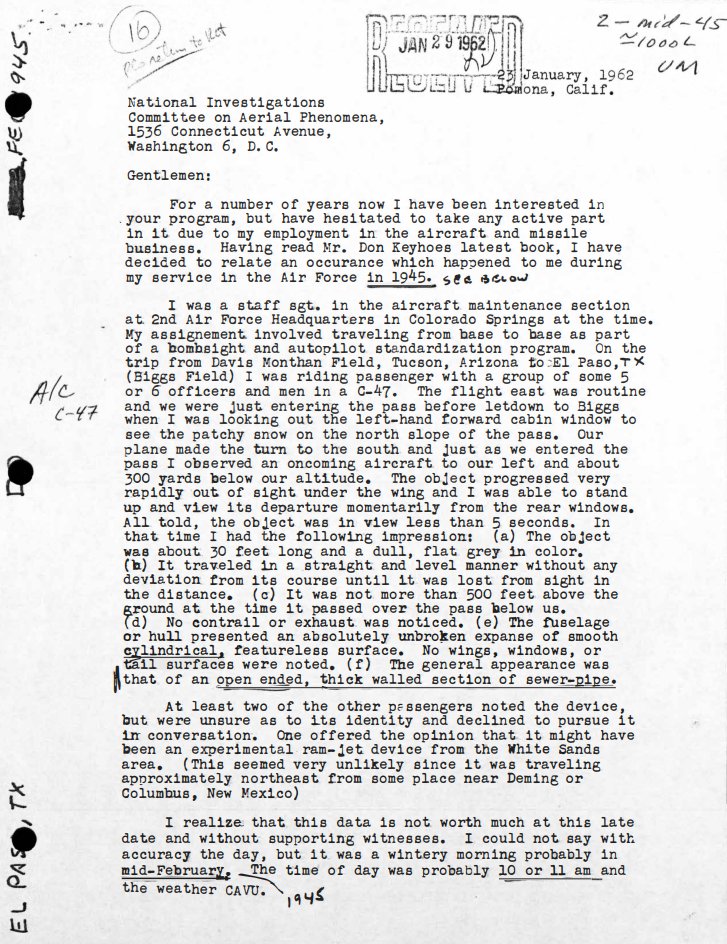
|
23 january, 1962
Pomona, Calif.
National Investigations
Committee on Aerial Phenomena,
1536 Connecticut Avenue,
Washington 6, D. C.
Gentlemen:
For a number of years now I have been interested in your program, but have hesitated to take any active part in it due to my employment in the aircraft and missile business. Having read Mr. Don Keyhoe's latest book, I have decided to relate an occurrence which happened to me during my service in the Air Force in 1945.
I was a staff sgt. in the aircraft maintenance section at 2nd Air Force Headquarters in Colorado Springs at the time. My assignment involved traveling from base to base as part of a bombsight and autopilot standardization program. On the trip from Davis Monthan Field, Tucson, Arizona to El Paso, TX (Biggs Field) I was riding passenger with a group of some 5 or 6 officers and men in a C-47. The flight east was routine and we were just entering the pass before letdown to Biggs when I was looking out the left-hand forward cabin window to see the patchy snow on the north slope of the pass. Our plane made the turn to the south and just as we entered the pass I observed an oncoming aircraft to our left and about 300 yards below our altitude. The object progressed very rapidly out of sight under the wing and I was able to stand up and view its departure momentarily from the rear windows. All told, the object was in view less than 5 seconds. In that time I had the following impression: (a) The object was about 30 feet long and a dull, flat grey in color. (b) It traveled in a straight and level manner without any deviation. from its course until it was lost from sight in the distance. (c) It was not more than 500 feet above the ground at the time it passed over the pass below us. (d) No contrail or exhaust was noticed. (e) The fuselage or hull presented an absolutely unbroken expanse of smooth cylindrical, featureless surface. No wings, windows, or tail surfaces were noted. (f) The general appearance was that of an open ended, thick walled section of sewer-pipe. At least two of the other passengers noted the device, but were unsure as to its identity and declined to pursue it in conversation. One offered the opinion that it might have been an experimental ram-jet device from the White Sands area. (This seemed very unlikely since it was traveling approximately northeast from some place near Deming or Columbus, New Mexico)
I realize that this data is not worth much at this date and without supporting witnesses. I could not say accurately the day, but it was a wintery morning probably mid-February. The time of day was probably 10 or 11 am the weather CAVU [1].
[1] CAVU is abbreviation for “Ceiling and Visibility Unlimited” (and unrestricted). It is an operational term no longer formally defined in meteorology, but still commonly used in aviation, that designates a condition wherein the ceiling is more than 10 000 feet and the visibility is more than 10 miles.
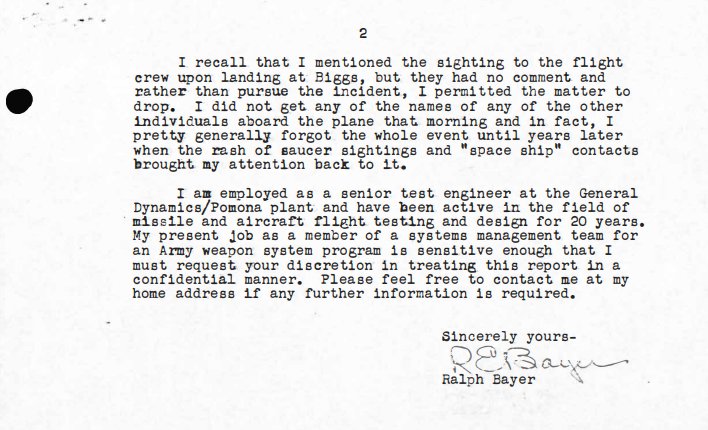
|
2
I recall that I mentioned the sighting to the flight crew upon landing at Biggs, but they had no comment, and rather than pursue the incident, I permitted the matter to drop. I did not get any of the names of any of the other individuals aboard the plane that morning and in fact, I pretty generally forgot the whole event until years later when the rash of saucer sightings and “space ship” contacts brought my attention back to it.
I am employed as a senior test engineer at the General Dynamics/Pomona plant and have been active in the field of missile and aircraft flight testing and design for 20 years. My present job as a member of a systems management team for an Army weapon system program is sensitive enough that I must request your discretion in treating this report in a confidential manner. Please feel free to contact me at my home address if any further information is required.
Sincerely yours
Ralph Bayer
[Ref. dwn3:] DOMINIQUE WEINSTEIN:
Mid-February, 1945 Texas, USA
Between 1000 and 1100, Ralph Bayer pilot of a USAAF C-47 of the 2nd Air Force Headquarter flew with 5 to 6 passengers from Davis Monthan Field (Tucson, Arizona) to Biggs Filed (El Paso, Texas). The pilot and two other passengers saw a dull flat grey in color cylindrical-shaped object (30 ft long) flying in straight line and level manner without any deviation from its course. It approached below the plane from the left and at 500 ft above the ground (below the plane). No contrail or exhaust was noticed and it had an “open ended thick walled section of sewer-pipe”. It progressed very rapidly out of sight under the aircraft wing. Total duration: less than 5 seconds. Weather was CAVU.
In 1962, Ralph Bayer was Senior test engineer at the General Dynamics Ponoma Plant in California, working on an Army weapon system program.
Sources: Project 1947, NICAP Files, Jan Aldrich and Barry Greenwood / Signed report by Ralph Bayer sent to NICAP on 23 / 01 / 1962.
[Ref. gvo1:] GODELIEVE VAN OVERMEIRE:
1945, mid February
USA, Texas
The pilot of a C47 (2nd AF headquarters) and two passengers observe a cylindrical, flat, dark gray object, 30 feet long, flying in a straight line (PROJECT ACUFOE, Catalog 1999, Dominique Weinstein)
[Ref. get1:] GEORGE M. EBERHART:
Mid-February - As their C-47 prepares to land at Biggs Field, Fort Bliss, El Paso, Texas, S/Sgt Ralph Bayer is alarmed to see an aircraft approaching from the left and only 900 feet below them. The object is about 30 feet long and a dull, flat gray in color, and it travels in a straight course 500 feet above the ground until it disappears. (Clark III 1178)
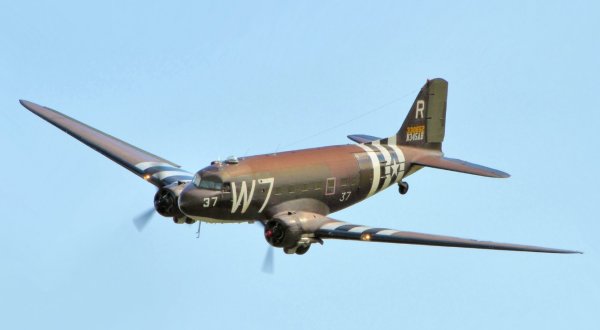
|
The C-47 was the Douglas C-47 “Skytrain” (photo above), a transport aircraft of the US Army Air Forces, which was one of the military versions of the Douglas DC-3. It was a versatile, robust and easy-to-maintain transport plane, used on all fronts during and after the Second World War.
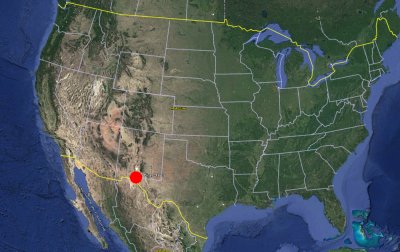
|
Places mentioned in the report:
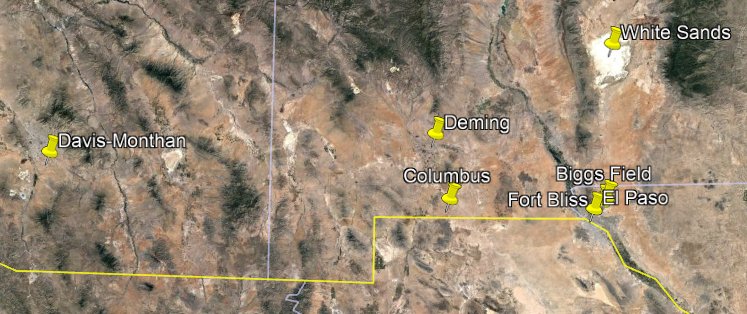
|
Ralph Bayer appears in various public publications of General Dynamics, such as General Dynamics News in 1963.
It was not absurd in 1945 that other witnesses on the plane thought the craft was an experimental device from White Sands. Already during the Second World War, new weapons were tested there. The idea for a ramjet device obviously came from the UFO's pipe appearance; a ramjet produces its thrust by reaction by ejection of gases from the combustion of a fuel, generally kerosene, and it is made up of only a tube, with no moving parts.
But no ramjet aircraft was then flight tested around White Sands in 1945, and such an aircraft would still have had wings and fin. For example, the first American ramjet aircraft, in 1947, was a conventional Lockheed P-80 “Shooting Star” jet aircraft on which Marquardt C-30 ramjets were added at the wingtips (photo below).
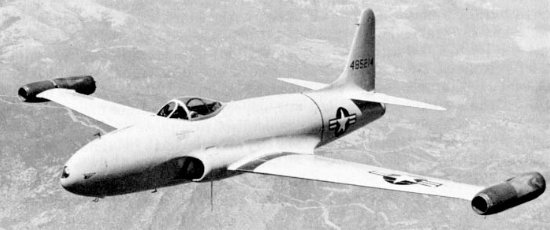
|
Possible extraterrestrial craft.
* = Source is available to me.
? = Source I am told about but could not get so far. Help needed.
| Main author: | Patrick Gross |
|---|---|
| Contributors: | None |
| Reviewers: | None |
| Editor: | Patrick Gross |
| Version: | Create/changed by: | Date: | Description: |
|---|---|---|---|
| 0.1 | Patrick Gross | December 12, 2023 | Creation, [nip1], [dwn3], [gvo1], [get1]. |
| 1.0 | Patrick Gross | December 12, 2023 | First published. |